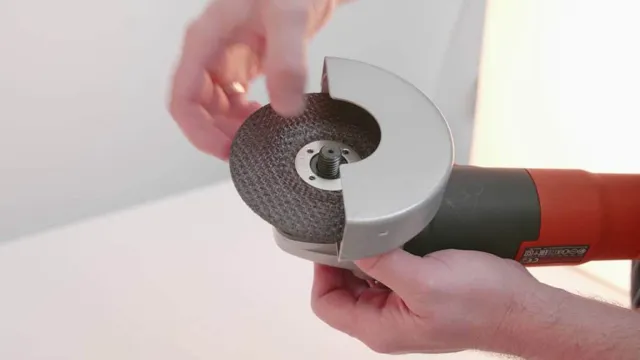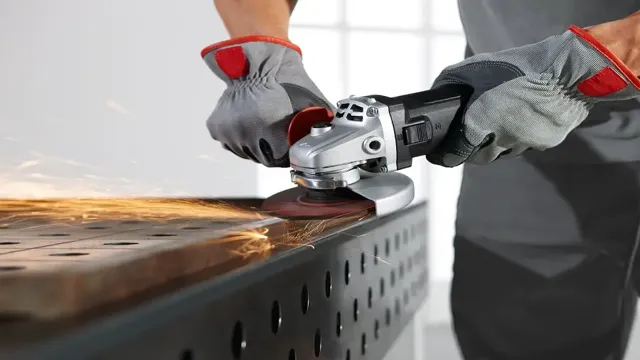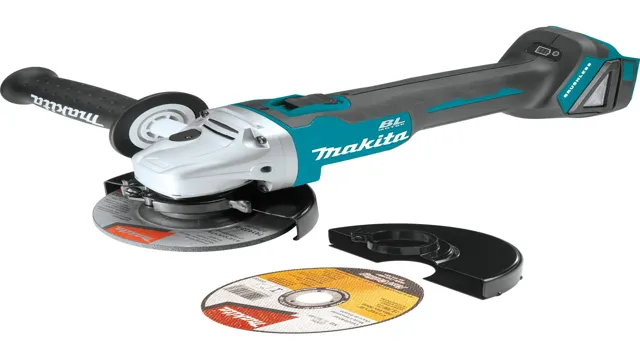Can You Put a Polishing Wheel on an Angle Grinder? The Ultimate Guide
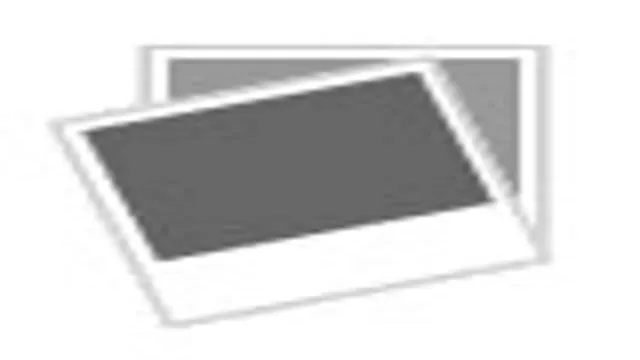
Have you ever found yourself in need of a polishing wheel but only have an angle grinder on hand? Fear not, as using a polishing wheel on an angle grinder is a common solution for many DIY and professional projects. With the right attachment and technique, an angle grinder can quickly turn into a versatile polishing tool for metal, concrete, and even wood surfaces. It’s like having a multi-purpose tool in your toolbox that can get the job done in half the time.
In this blog post, we will dive into the steps and tips for using a polishing wheel on an angle grinder, and how it can save you time and effort in your next project. So, grab your angle grinder and let’s get polishing!
What You Need to Know Before Starting
If you’re wondering whether you can attach a polishing wheel to an angle grinder, the answer is yes! However, there are a few things you need to know beforehand. First off, you need to make sure that the polishing wheel you’re using is compatible with your angle grinder. Check the manufacturer’s guidelines to ensure compatibility.
Secondly, you need to pay close attention to the speed settings of both the angle grinder and the polishing wheel. Polishing wheels typically run at lower speeds than angle grinders, so make sure you adjust the speed accordingly. Lastly, always wear the appropriate protective gear, including a dust mask and safety goggles.
With these precautions in place, you can safely use an angle grinder with a polishing wheel to create a polished finish on a variety of materials.
Choosing the Right Polishing Wheel
Choosing the right polishing wheel can be a daunting task, especially for those who are new to the trade. By understanding the basics of the materials used, you can make an informed decision. The most common materials used for polishing wheels are cotton, sisal, and felt.
Cotton wheels are ideal for pre-polishing and high-gloss finishes, while sisal wheels are perfect for coarser grits and heavy-duty work. Felt wheels are the go-to choice for final polishing, as they provide a soft yet durable surface. It’s important to choose the right size of the polishing wheel to match your machine’s arbor size, and to determine whether you need a loose or tight sewn wheel depending on the amount of pressure you’ll be applying.
So, before you start polishing, consider the materials you’ll be working with and choose the appropriate wheel for the job at hand.
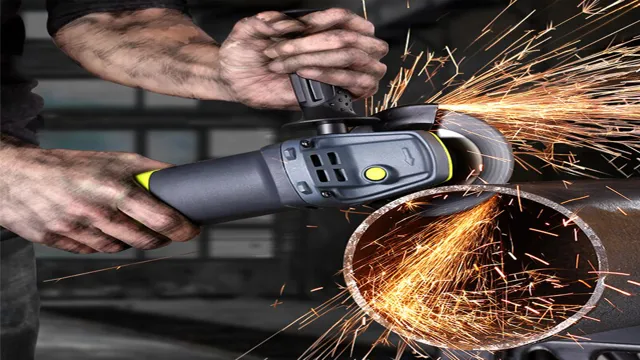
Selecting the Proper Angle Grinder
When it comes to selecting the proper angle grinder, there are a few key things you need to know before starting. First and foremost, it’s important to consider the job you need to do and the type of material you’ll be working with. Different grinders are designed for different purposes and materials, so make sure you choose one that is appropriate for your specific needs.
Additionally, you should consider the size and power of the grinder, as this will also impact its effectiveness. It’s also important to consider safety features, such as guards and emergency stop buttons, to ensure that you are using the grinder safely. By taking the time to carefully consider these factors, you can select the proper angle grinder that will help you complete your job safely and efficiently.
Using the Correct Safety Equipment
Before starting any task, it is essential to understand the importance of using the correct safety equipment. The right safety equipment can save your life and help you avoid serious injuries. Among other things, you should consider using eye, ear, respiratory or head protections depending on the task at hand.
It is also essential to ensure that the safety equipment is correctly fitted and positioned, with regular maintenance checks to ensure they are in good working condition. Whether you’re working in construction or doing home improvements, you should always take the right precautions to avoid accidents. Additionally, wearing safety equipment portrays a positive image to clients, co-workers, and managers, showing that you take safety seriously.
With that said, always use suitable safety equipment before starting any task to ensure your safety.
Installing the Polishing Wheel
Yes, you can put a polishing wheel on an angle grinder! It’s a great way to convert your angle grinder into a versatile tool for polishing, buffing and finishing metal surfaces. However, you need to make sure you choose the right type of polishing wheel that is compatible with your angle grinder’s size and speed. Most polishing wheels are designed for use with electric or cordless drills, which have a lower RPM range than angle grinders, so you’ll want to look for a specialized polishing wheel made specifically for use with angle grinders.
Once you have the right polishing wheel, installation is quick and easy. Simply secure the wheel onto the grinder’s threaded arbor using the included nut and tighten with a wrench. Remember to always wear protective gear when using an angle grinder, including safety glasses and gloves, and follow proper operating procedures to ensure your safety and the best results.
Removing the Grinder Disc
When it comes to transforming your grinder into a polishing machine, it’s important to carefully remove the grinder disc and install the polishing wheel. Begin by unplugging the grinder and removing any attached accessories or guards. Locate the spindle lock button, typically located near the wheel and press it down while rotating the grinder wheel until it locks into place.
Then use a wrench to loosen and remove the bolt holding the grinder disc in place. With the grinder disc removed, carefully attach the polishing wheel making sure to align it with the markings on the spindle. Secure it in place with the bolt and tighten with the wrench.
Test the new polishing wheel before use to ensure it’s securely attached and free from any wobbling. With a bit of practice and patience, you’ll be able to easily switch between a grinding and polishing function on your machine.
Attaching the Polishing Wheel Adapter
Attaching the polishing wheel adapter is a critical step when you are installing the polishing wheel. The polishing wheel adapter is the tool that helps you attach the polishing wheel to the bench grinder. To attach the adapter to the bench grinder, follow the instructions provided by the manufacturer.
Usually, the adapter consists of two pieces that need to be assembled together. Once the adapter is assembled, you can attach the polishing wheel to the adapter and tighten it using a wrench. Make sure you tighten the wheel securely because a loose wheel can be dangerous.
It is essential to ensure that the adapter and the polishing wheel are compatible with the bench grinder. As a proactive measure, always check the compatibility before purchasing the adapter and polishing wheel. With the adapter in place, you can now proceed to install the polishing wheel.
Mounting the Polishing Wheel
Mounting the polishing wheel can be a bit tricky but with a few simple steps, you can make the process a lot easier. First, make sure that your polishing machine is turned off and unplugged, that there are no loose or damaged parts, and that the area around the machine is clear. Then, locate the spindle on your machine and check it for any signs of damage.
If everything appears to be in good working order, take your polishing wheel and center it on the spindle. Tighten the spindle lock firmly to hold the wheel in place. Be sure to align the wheel properly to avoid any wobbling or imbalance during use.
Once the wheel is installed, double check all fittings to ensure they are secure before turning the machine on. Always follow the manufacturer’s instructions and safety guidelines when mounting the polishing wheel to ensure a safe and effective polishing process. By taking the time to correctly install the wheel, you can maintain the quality of the polishing finish and increase the lifespan of your machine.
Polishing Techniques
When it comes to polishing techniques, people often wonder if they can put a polishing wheel on an angle grinder. The answer to this question is yes, but there are some things you should know before doing so. First, not all angle grinders are created equal, and some may not have the necessary speed or power to handle a polishing wheel.
It’s important to check the manufacturer’s recommendations for your specific angle grinder before attempting to attach a polishing wheel. Additionally, you’ll need to make sure the polishing wheel you use is compatible with your angle grinder. If you do decide to use an angle grinder for polishing, it can be a cost-effective solution compared to purchasing a separate polishing tool.
However, it’s important to take proper safety precautions, such as wearing protective eyewear and gloves, and ensuring the angle grinder is securely fastened to a stable work surface. With proper care and attention, an angle grinder can be a versatile and effective tool for polishing a variety of surfaces.
Adjusting the Speed
When it comes to polishing, adjusting the speed can be an essential technique to achieve the desired results. Whether you’re working with a rotary or dual-action polisher, changing the speed can help you achieve different levels of cut and finish. Slower speeds are perfect for applying polishing compounds, while higher speeds are more suitable for removing deeper scratches and defects.
Keep in mind the type of pad you’re using, as heavier pads generally require slower speeds to avoid overheating and burning the paint. Adjusting the speed is a great way to fine-tune your polishing technique, giving you greater control over the process and achieving a flawlessly polished surface. So, if you’re looking to achieve the perfect shine on your car, take the time to experiment with different speeds and see how they affect your results.
Using the Correct Pressure
When it comes to polishing techniques, using the correct pressure can mean the difference between a polished finish and a ruined one. The pressure you apply when buffing or polishing depends on the material you are working with and the level of abrasion you want to achieve. For example, polishing a delicate piece of jewelry requires a light touch, whereas removing oxidation from a rusted metal surface requires a more forceful approach.
It’s essential to note that applying too much pressure could damage the surface you’re working on, creating more work for you in the long run. A general rule of thumb is to start with a light pressure and gradually increase it until you reach your desired level of abrasion. Taking a systematic approach to applying the right amount of pressure will ensure you achieve a polished surface without causing any damage.
Maintenance and Cleaning
Yes, you can put a polishing wheel on an angle grinder. However, there are some considerations to keep in mind before doing so. First, ensure that the polishing wheel is the correct size to fit onto your angle grinder.
You don’t want to force a wheel that’s too big or small onto your grinder, as this could damage the tool. Additionally, make sure that the polishing wheel is designed for use with an angle grinder. Some polishing wheels may not be suitable for this type of tool and could cause safety issues.
When using a polishing wheel on your angle grinder, it’s important to take all necessary safety precautions. This includes wearing proper protective gear, such as gloves and eye protection, and ensuring that the tool is properly secured and stable before use. Always follow manufacturer instructions and recommendations for both the angle grinder and polishing wheel to avoid accidents or injuries.
Regular maintenance and cleaning are also crucial to the longevity and effectiveness of your angle grinder and polishing wheel. Clean the tool thoroughly after each use and inspect it for any signs of wear or damage. Replace worn or damaged parts immediately to avoid potential safety hazards or reduced performance.
By taking good care of your angle grinder and polishing wheel, you’ll be able to use them safely and effectively for years to come.
Properly Storing the Polishing Wheel
Properly storing your polishing wheel is crucial to ensure its longevity and effectiveness in achieving a smooth and glossy surface every time. Maintenance and cleaning go hand in hand when it comes to polishing wheels. Prior to storing the wheel, remove any excess polishing compound and debris using a wire brush or soft cloth.
The wheel should then be thoroughly cleaned with a mild soap and water solution, avoiding harsh chemicals that may cause damage to the wheel’s surface. After cleaning, dry the wheel completely to prevent any moisture buildup that could result in rust or corrosion. When it comes to storage, keep the wheel in a dry and cool place, away from direct sunlight.
Avoid stacking multiple wheels on top of each other to prevent deformation. Lastly, consider covering the wheel with a protective material to prevent any dust accumulation. By following these simple maintenance and storage guidelines, you can keep your polishing wheel running smoothly for years to come.
Cleaning the Angle Grinder
Maintaining and cleaning your angle grinder is crucial in extending its lifespan and ensuring its efficiency. After every use, make sure to wipe down the grinder’s exterior using a dry cloth to remove any debris or dust. For a more thorough cleanup, disassemble the grinder and clean each part separately.
Dip a brush in a cleaning solution, such as acetone or brake cleaner, and scrub away any leftover material. Be sure to wear protective gloves to avoid direct contact with the chemicals. Once all the parts are clean, reassemble the grinder and run it for a few seconds to dry off any excess moisture.
Keeping your angle grinder clean and well-maintained prevents damage or malfunction and ensures it’s always ready for your next project. Remember, taking care of your tools means taking care of your work.
Maintaining the Polishing Wheel
Maintaining the polishing wheel is essential not only for keeping it working effectively but also for ensuring its longevity. A good maintenance routine includes regular cleaning and polishing of the wheel, as well as proper storage when not in use. When cleaning the polishing wheel, it is important to use the right tools and cleaning agents for the job.
Abrasive pads and harsh chemicals are generally not recommended, as they can damage the wheel’s polishing surface. A soft-bristled brush, mild soap, and water are often sufficient for cleaning the wheel. After cleaning, it is important to dry the polishing wheel thoroughly to prevent rust and other forms of corrosion.
Additionally, it is essential to store the polishing wheel in a dry and cool location, away from direct sunlight or other sources of heat, humidity, or moisture. By following these simple maintenance steps, the polishing wheel will remain in excellent condition, enabling you to achieve the best results and extend the life of the wheel.
Conclusion
In summary, while it may be possible to put a polishing wheel on an angle grinder, it’s not necessarily the best or safest option. As with most DIY projects, it’s important to consider the potential risks and drawbacks before diving in. So before you go ahead and attach that polishing wheel to your angle grinder, make sure you do your research and weigh up all the pros and cons.
After all, a little bit of caution now could save you a lot of hassle and headache down the line!”
FAQs
What is an angle grinder?
An angle grinder is a handheld power tool used for cutting, grinding, and polishing.
Can you put a polishing wheel on an angle grinder?
Yes, you can put a polishing wheel on an angle grinder as long as it is the correct size and speed rating for the grinder.
What is the recommended speed for polishing with an angle grinder?
The recommended speed for polishing with an angle grinder is between 2,500 and 4,000 RPM.
What type of polishing wheel should I use on an angle grinder?
You should use a polishing wheel with a soft, fine-grit surface for polishing with an angle grinder.
How do I attach a polishing wheel to an angle grinder?
To attach a polishing wheel to an angle grinder, first secure the grinder onto a work surface and then attach the polishing wheel using the appropriate arbor attachment.
Can I use water while polishing with an angle grinder?
Yes, you can use water when polishing with an angle grinder to help cool down the surface and extend the life of the polishing tool.
How do I maintain my polishing wheel for use with an angle grinder?
To maintain your polishing wheel for use with an angle grinder, clean it regularly with a stiff-bristled brush and replace it once the surface becomes worn or damaged.
